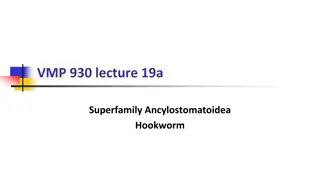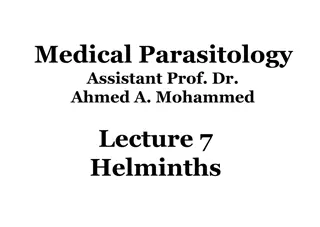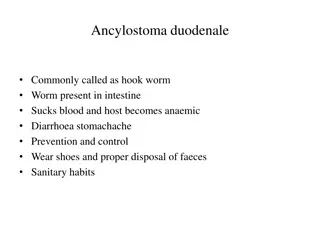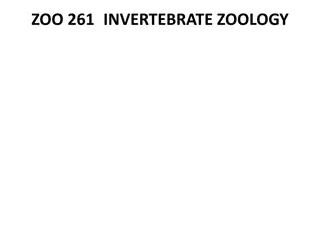Understanding the Hookworm Superfamily Ancylostomatoidea
The superfamily Ancylostomatoidea includes blood-feeding parasites like hookworms, with important species such as Ancylostoma caninum in dogs and Ancylostoma duodenale in humans. These parasites have a complex lifecycle involving transmission through the environment and development within the host.
0 views • 31 slides
Overview of Ancylostoma duodenale (Hookworm) Infection
Ancylostoma duodenale, a parasitic worm causing Ancylostomiasis, is discussed in this lecture. The infection's distribution, morphology, life cycle, and pathology are detailed, emphasizing the impact on humans. The lifecycle stages, including egg production, larval development, and entry into the hu
0 views • 12 slides
Common Human Intestinal Parasites and Their Prevention
Ancylostoma duodenale, Wuchereria bancrofti, Dracunculus medinensis, and Enterobius vermicularis are common human parasites causing various diseases. From hookworms to pinworms, these parasites can lead to anemia, filariasis, elephantiasis, and inflammation. Proper sanitation and hygiene practices,
0 views • 9 slides
Exploring the World of Invertebrate Zoology: Phylum Nematoda and Its Classes
In this detailed study of invertebrate zoology, we delve into the Phylum Nematoda, commonly known as roundworms. Highlighting their anatomy and classification, we examine the Ascarididae class, featuring Ascaris, and the Strongylidae class, represented by Ancylostoma. These simple yet diverse organi
0 views • 171 slides
Overview of Strongyloidea Parasites in Veterinary Parasitology
This informative text covers the morphology, life cycle, and common genera of Strongyloidea parasites, including Ancylostoma caninum and Bunostomum sp. It also discusses the occurrence of cutaneous larva migrans and details the Superfamily Trichostrongyloidea. Profound insights into practical parasi
0 views • 11 slides




